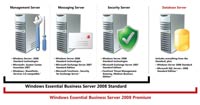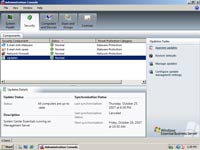Product Reviews
EBS 2008: Midsize Server Hits Midsize Mark
New, all-in-one tool handles core-computing chores without fuss.
Windows Essential Business Server (EBS) 2008 is not so much a new product as it is a collection of existing tools. And where Windows Small Business Server (SBS) provides the all-in-one package for smaller companies with a maximum of 75 users or devices, EBS 2008 fills a server role for midsize organizations that have up to 300 users or devices.
There are two editions for midsize businesses to choose from (see Figure 1). EBS Standard Edition allows for three physical servers and includes Windows Server 2008 Standard, the all-new System Center Essentials, SharePoint Services 3.0 (available via download), Exchange 2007 and Forefront Security Server (Security for Exchange Server and Threat Management Gateway). EBS Premium Edition adds a fourth database server running SQL Server 2008 to the Standard Edition. Interestingly, through Dec. 31, 2009, Windows Server 2003 Standard and SQL Server 2005 are available instead of the newest releases.

[Click on image for larger view.] |
| Figure 1. The full range of Windows Essential Business Server options. |
Any experienced Windows SBS administrator knows there are pros and cons to an all-in-one setup; the same holds true for the midmarket choice. Obviously cost is the main factor in a decision to implement EBS. With a starting price of $5,067 for Standard and $6,188 for Premium, the savings are drastic compared to buying these server licenses individually. But with EBS, there's more to it than that.
The Pros of EBS 2008- The Administration Console: At first blush, EBS sounds like Windows SBS 2008 spread out to accommodate a larger workload. But something else sets it apart. That something is the System Center Essentials Administration Console. From the "Manage My Server" days to the newest SBS console, we've never found these consoles useful. It's just as simple, and at times faster, to browse through the Microsoft Management Console (MMC) or management area of any one feature you need to control.
This time, however, Microsoft has succeeded in making a one-stop console to manage and review your system's health, performance and features. The opening page of this Administration Console, System Health, displays issues that need immediate attention. As a marketing phrase, Microsoft calls this the "bet your job" view -- because if something's wrong here, you can bet your job you'll be hearing about it from your users. System Health is broken down into three areas: log on to domain, send and receive e-mail, and Internet access.
When an alert is shown, the console even gives helpful suggestions for resolving the issue. It notifies you of stopped services with links that quickly allow you to attempt a restart of the service. Even if this feature has just been executed at the start of the day, the console provides a quick overall health check of your organization. It's no secret that anything that makes the day easier is a plus for admins.
- Speed: If you've worked with SBS 2008, you know sluggishness is the downfall of the SBS Console. It starts, the icons spin and spin, and eventually the "querying" finishes and the console shows the current state of your server. With EBS, the console's layout alone alleviates some of the performance problems (see Figure 2). It feels less like the operating system is "protecting" you inside a rubber room, and more that you've been placed at the control deck. Tab by tab, you can view and manage your server and network.

[Click on image for larger view.] |
| Figure 2. The Windows Essential Business Server Administration Console. |
- Creating New Users: In looking under the Users and Groups tab, an administrator can create new users simply, with all the aspects of a unique domain completed at the same time and from the same screen. When starting the New User Account wizard, there's the obligatory "Getting Started" page, otherwise known as the "just click next page" page. Thankfully you can check a box and never see this page again. Next, a screen you really want to see will check prerequisites for a new user, such as Client Access License (CAL) availability. After adding the user information, setting the password and assigning groups and a CAL, you can set up the mailbox. You also can redirect the user's "My Documents" before completing the addition of the user. This makes adding users a breeze for an EBS admin.
- Managing Updates: IT folks in mid-range environments rarely have an easy software-management solution. Small shops with 10 computers don't need to manage updates from one location. Chances are these 10 computers install updates automatically. In very large environments, on the other hand, there's more red tape, in addition to more tools and more resources needed to manage them. But what about the guy in the middle? An administrator with 150 computers probably doesn't have the budget for the high-end approach that big enterprises would take; nor does a mid-range admin want desktops and servers installing anything they feel like. EBS makes it easy to manage updates for both your desktops and your servers. Using Windows Software Update Services (WSUS), you quickly see which updates are available and can approve or block them. You can even choose by group which set of computers should receive an update and when. It's a time-saving feature, and, more importantly, it allows you to be more mindful of how you're updating your network.
- Windows Remote Assistance: Saving resources, time and effort: these are the winning points of EBS, and the Remote Assistance feature is another example of how this is achieved. When responding to user problems as an administrator, you can walk to a user's desk (if the user is in the same physical location) or use Remote Desktop to take over and control the client's computer. Remote Assistance lets you help users without making them cede control of their machines. That's helpful, especially if you'd like the user to show the action causing the issue -- or if you want to show users how to correct the issue so they don't call next time. During the assistance session, you can chat or send a file. Many problems can be resolved right from your own desk. Most likely, you're using some form of Remote Assistance to respond to issues that arise, but it's nice to have all the options in one place and included with your server purchase and setup.
- Remote Web Workspace: Beyond granting access to Outlook Web Access, you can now give users a secure, remote access point to the network. This can potentially eliminate the need for additional equipment like a VPN, VPN concentrator or Terminal Server. This feature is handy for the administrator on the go because you can take control of either the server or the computers on the network in order to perform administrator functions from wherever you may be.
So far, this review has been quite the sales pitch. Have we got you ready to drop a few more dollars Microsoft's way? Before you do -- and many will -- you might as well hear the cons of EBS.
The Cons of EBS 2008
- Licensing: Yes, it's the de facto con of the Microsoft world. The folks in Redmond tried to make licensing a positive this time around with new licensing management tools: There's one CAL for all the servers included in EBS Standard, and just one extra for those businesses needing to use the Premium features. But that's just like putting your ugly date in a nicer dress (or suit, ladies). The fact is, Microsoft server licensing stinks. When you buy EBS -- or any server, for that matter -- why do you need access licenses for each user or device? You bought the server OS; you bought the desktop OS. Now you have to pay for stamps to make them pen pals. It just doesn't make sense.
- Physical Servers Requirements: Setting up EBS requires three physical (or virtual) servers to handle the roles of management server, messaging server and security server. That number becomes four if you plan to purchase the Premium edition and use a database server. These requirements do cut into -- if not eliminate -- the financial benefits of EBS for companies on the smaller side of the midsize business category. Even at 300 users, you may not already have three or four servers dedicated to these roles. And if you're just outgrowing SBS, the jump to three servers is less of a jump and more of a huge leap.
Microsoft does discuss using Hyper-V to consolidate physical servers and allow the entire EBS install to exist on just one box. However, this can restrict room for future growth. Additionally, the cost of a high-end server running Hyper-V and multiple EBS instances may be too high for a midsize budget. Either way, virtualization is a key issue in deciding whether to go with EBS or a straight installation of Windows Server with the additional roles that make sense for your organization.
- Installation: What a nightmare! It's true that once you get the servers up and running, you'll have a great setup. But going through the various wizard screens for the Windows EBS Planning and Preparation applications is a tedious, lengthy, inflexible process. For example, you can't move forward with the installation of a server until you answer all the wizard questions, create an .XML file and then use that .XML file when performing the installation of the servers. For an SBS administrator moving up to EBS, the process shouldn't feel overly restrictive. But for those of us who are used to running full-version server products, it feels as though you're being hand-held the whole way.
| REDMOND RATING | Installation 20% | 2.0 | Features 20% | 9.0 | Ease of use 20% | 10.0 | Administration 20% | 9.0 | Documentation 20% | 5.0 | Overall Rating: | 7.0 |
Key: 1: Virtually inoperable or nonexistent 5: Average, performs adequately 10: Exceptional |
|
|
EBS 2008: Thumbs up or Down?
We're going to go with thumbs up on this one. It's obvious that the EBS development team held true to its path: The primary goal was to provide a better experience to midsize businesses, and EBS has done that. Better consoles; more tools; more flexibility over SBS; a tremendous lineup of servers including Exchange, SQL, System Center Essentials, Forefront; and the list goes on. EBS really is a cornucopia of necessary software for the midsize business, and it includes a solid set of admin tools that allow the IT administrator to work strategically, not just reactively.
Windows Essential Business Server 2008
Standard Edition: $5,067; Premium Edition: $6,188
Microsoft Corp.
425-882-8080
www.microsoft.com